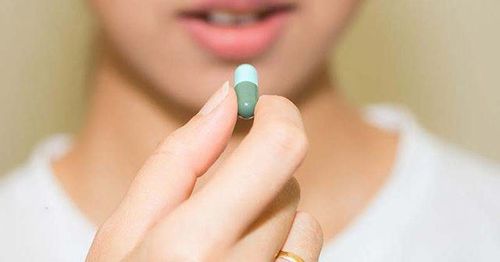This is an automatically translated article.
Esmolol is a short-acting, selective beta1-blocker. Esmolol is indicated for use in the treatment of supraventricular tachyarrhythmias; increased blood pressure and tachycardia during - after surgery. The following article provides you with information about the uses and uses of Esmolol.1. What is the effect of Esmolol?
Esmolol is a short-acting, selective beta-1 blocker. Esmolol has similar pharmacological effects to other beta-blockers. Esmolol selectively inhibits the sympathetic stimulation response by competitively blocking cardiac beta-1 receptors. Esmolol has a weak effect on beta-2 receptors of bronchial and vascular smooth muscle.
When using high doses above 300 mcg/kg/min, the selectivity of Esmolol on beta-1 receptors is reduced, the drug competitively inhibits both beta-1 and beta-2 receptors.
In in vitro studies, the beta1-blocking activity of Esmolol on a molecular basis was approximately 1.5-2.5% propranolol, 10-20% metoprolol, 7% labetalol. In in vitro studies in animals and humans, the beta-1-blocking effect of Esmolol on a mass basis was approximately 3-10% of Propranolol in the isoproterenol-induced inhibition of exercise-induced tachycardia in patients with angina. stable chest or healthy person.
At clinical doses, Esmolol has no intrinsic sympathomimetic or membrane-stabilizing effects and no alpha-receptor blockade. However, Esmolol exhibits sympathomimetic and membrane-stabilizing effects when administered at doses greater than those commonly used in clinical practice.
The drug has the following dosage forms and strengths:
5ml vial, 20mg/ml intravenous solution. 10ml vial, 10mg/ml intravenous solution. 100ml bag, 20mg/ml intravenous solution. 250ml bag, 10mg/ml intravenous solution.
2. Indications and contraindications of Esmolol
Esmolol is indicated in the following cases:
Supraventricular tachyarrhythmias (including sinus tachycardia, atrial fibrillation, atrial flutter). Hypertension, tachycardia during and after surgery. In addition, Esmolol is used for children with congenital heart disease tetralogy of Fallot. Esmolol is contraindicated for use in the following cases:
2nd and 3rd degree atrioventricular block. Sinus bradycardia Shock of cardiac origin. Heart failure.
3. How to take Esmolol
3.1. How to use Esmolol is administered intravenously, the concentration of the solution should not exceed 10mg/ml. Esmolol must not be given through small veins or through a butterfly needle. In children, Esmolol must be given via a central venous catheter.
3.2. Dosage of Esmolol Adult
Supraventricular tachyarrhythmias: Initially 500 mcg/kg IV over about 1 minute, then a maintenance intravenous infusion at a rate of 50 mcg/kg/min over 4 minutes. If the patient responds well, it can be maintained at this infusion rate. If the patient does not achieve a satisfactory response within the first 5 minutes, give an additional IV loading dose of 500 mcg/kg over approximately 1 minute, then increase the maintenance infusion rate to 100 mcg/kg/min over 4 minutes. If necessary, continue to repeat the above treatment cycle until the patient achieves an adequate response, each time increasing the maintenance infusion rate by 50 mcg/kg/min up to a maximum dose of 200 mcg/kg/min . Each dose adjustment of Esmolol includes a loading (attack) dose and a maintenance dose. Once the patient achieves the desired response, continue the intravenous line as needed, up to 48 hours. When switching to another antiarrhythmic agent, 30 minutes after the substitution, the dose of Esmolol should be reduced by 50%, and 1 hour after the second dose of the drug, Esmolol should be discontinued. Hypertension, tachycardia during and after surgery: During anesthesia: For immediate control, administer 80mg of Esmolol intravenously over 15-30 seconds, then intravenously at a rate of 150mcg/ kg/min, may be increased to a maximum dose of 300 mg/kg/min. During recovery from anesthesia: 500 mcg/kg/min IV over 4 minutes, then, if necessary, can be maintained intravenously at a dose of 300 mcg/kg/min. After surgery: Apply the same dosage and administration method for the treatment of supraventricular tachyarrhythmias. Children
Emergency arrhythmia and hypertension: Apply to children from 1 month to 18 years old: Initially 500mcg/kg intravenously over about 1 minute, then maintain intravenous infusion at the rate of 50mcg/kg /min for 4 minutes (if heart rate is low and blood pressure is too low, the infusion rate may be reduced). If the pediatric patient has not achieved a satisfactory response, administer a loading dose of 500 mcg/kg IV over 1 minute, increasing the maintenance infusion rate to 100 mcg/kg/min over 4 minutes. If necessary, continue to repeat the above treatment cycle until the patient achieves an adequate response, with each repetition increasing the maintenance infusion rate by 50 mcg/kg/min until 200 mcg/kg/min is reached. minute. The use of Esmolol at doses above 300 mcg/kg/min is not recommended. Congenital tetralogy of Fallot: for neonates: Initial dose is 600 mcg/kg intravenously over 1-2 minutes, if necessary, a maintenance intravenous infusion of 300 - 900 mcg/kg/min can be used. 3.3. Esmolol Overdose and Management Symptoms that may occur with an overdose of Esmolol include: hypotension, symptomatic bradycardia, severe atrioventricular block, decreased conduction, defects in ventricular conduction, decreased myocardial contractility, acute heart failure, cardiac arrest, shock, convulsions... Sensitive patients may experience bronchospasm, electromechanical dissociation, hypoglycemia, loss of consciousness. Severe cases can lead to death or permanent disability. The lethal dose of Esmolol ranged from 0.625 to 2.5 g (12.5 to 50 mg/kg).
At that time, the patient needs to stop taking Esmolol immediately, mainly for symptomatic and supportive treatment. In the presence of symptomatic bradycardia, intravenous anticholinergics (eg, atropine sulfate) may be used.
In case of symptomatic hypotension: fluids and drugs to increase blood pressure are indicated; heart failure state indicated cardiac glycosides, diuretics. Intravenous glucagon is recommended for myocardial depression and hypotension caused by beta-blocker overdose. Use β2-adrenergic agonists or theophylline derivatives, Ipratropium when the patient develops bronchospasm. Some cases of β-adrenergic blocker overdose have been treated with intravenous calcium or insulin plus glucose infusion. Isoproterenol is used to treat shock or hypotension, if used with extreme caution and however best not used.
4. Esmolol side effects
Using Esmolol you may experience some of the following side effects:
Some serious side effects: heart block, anaphylaxis, seizures, bronchospasm, pulmonary edema.
Cardiovascular: hypotension, peripheral anemia, bradycardia, chest pain, pulmonary edema, pulmonary congestion, pulmonary hypertension. Neurological: dizziness, headache, excitation, somnolence, confusion, asthenia, depression, speech disorder, abnormal thinking, tonic-clonic seizures. Gastrointestinal: nausea, vomiting, taste disturbances, constipation, dyspepsia, anorexia, abdominal pain. Respiratory: bronchospasm, difficulty wheezing, nasal congestion, rales. Skin: pain at injection site, skin discoloration at injection site, erythema, thromboembolism and local skin necrosis due to extravasation, edema. Other: urinary retention, visual disturbances, chills, fever, decreased hemoglobin, increased serum LDH. When side effects of Esmolol occur, the infusion rate should be reduced immediately or the infusion can be stopped if necessary.
Patients with bronchospasm should immediately discontinue the Esmolol infusion, and if necessary, a bronchodilator (β2-adrenergic receptor stimulator) should be used, but with extreme caution, especially if the patient has a tachycardia before.
If an anaphylactic reaction occurs with Esmolol, the patient usually responds poorly to usual doses of Epinephrine or may respond paradoxically. Consider ipratropium or glucagon for this patient. Ipratropium is also effective in the treatment of bronchospasm associated with anaphylaxis in patients receiving β-adrenergic blocking agents.
5. Notes when using Esmolol
In patients with congestive heart failure, Esmolol has a risk of further impairing myocardial contractility and exacerbating heart failure. Discontinue the drug at the appearance of signs of heart failure and administer specific therapy if necessary (cardiac glycosides, diuretics). In cases where it is imperative to continue treatment with Esmolol, when symptoms of heart failure are relieved, the drug can be re-infused at a slower rate. Esmolol may mask the symptoms of tachycardia due to hypoglycemia in patients with diabetes.
Patients with hemodynamic impairment or who are taking drugs that reduce peripheral resistance, decrease myocardial contractility, reduce myocardial perfusion or reduce the transmission of electrical impulses in the myocardium: caution should be exercised when using Esmolol. Fatalities have been reported with the use of esmolol in patients with complex medical conditions to control ventricular rate. Intravenous β-adrenergic blockers, including Esmolol, should be used with caution in patients with acute atrial fibrillation with severe left ventricular dysfunction, accessory pathways, or hypotension.
Do not use Esmolol in patients with vasoconstrictor hypertension associated with hypothermia.
Because Esmolol can cause hypotension, blood pressure should be checked before dosing, especially in patients with low blood pressure before treatment (systolic blood pressure < 105 mmHg and/or diastolic blood pressure < 50 mmHg). . Hypotension caused by Esmolol can cause sweating and drowsiness, but is usually asymptomatic. The antihypertensive effect of the drug increases with dose. Doses not exceeding 200 mcg/kg/min are not recommended for the treatment of supraventricular tachycardia.
Use of Esmolol in patients with renal failure is at risk of drug toxicity.
Pregnant women: There are no controlled studies with the use of Esmolol in pregnant women. Use of the drug in late pregnancy or during labor may cause bradycardia in the fetus, and the effects may persist after the infusion has been stopped. Esmolol should be used during pregnancy only when the benefit to the mother outweighs the risk to the fetus.
Lactating women: It is not known whether Esmolol is excreted in human milk, therefore caution should be exercised when administering the drug to a nursing woman.
Esmolol injection, infusion in sealed, unopened packages should be stored at room temperature (20-25oC), avoid places that are too hot or frozen.
Esmolol hydrochloride solution prepared at a concentration of 10mg/ml, stable for at least 24 hours if kept at 15-30°C or refrigerated in the following solutions: 5% dextrose; dextrose 5% and NaCl 0.45% or 0.9%; 5% dextrose and Ringer lactate; Ringer lactate; NaCl 0.45% or 0.9%; dextrose 5% and potassium chloride 40 mEq/liter.
Esmolol hydrochloride is physically and chemically compatible with digoxin, dopamine hydrochloride, lidocaine hydrochloride, fentanyl citrate, morphine sulfate, nitroglycerin. However, the compatibility also depends on a number of factors such as the solvent of the drug, the concentration of the drug, the pH of the solution and the temperature. Esmolol should only be mixed with these drugs after the solution for injection has been diluted to a concentration of 10 mg/ml with a suitable intravenous solution.
Esmolol hydrochloride is physically or chemically incompatible with furosemide, diazepam, sodium bicarbonate, warfarin. Esmolol must not be mixed with these drugs.
6. Drug interactions
Digoxin: Concomitant use with esmolol increases digoxin serum concentrations by 10-20%, digoxin does not affect the pharmacokinetics of Esmolol. The combination of Digoxin and Esmolol in the treatment of supraventricular tachyarrhythmias during cardiac surgery may reduce heart rate better than Esmolol alone. Verapamil: Concomitant use of intravenous β-adrenergic blocking agents, including Esmolol, with intravenous Verapamil has resulted in serious adverse reactions such as cardiac arrest leading to death. Vasopressors or inotropic drugs such as dopamine, norepinephrine, epinephrine: should not be used concurrently with Esmolol because of the risk of inhibiting myocardial contractility when systemic vascular resistance is high. The frequency and severity of anaphylactic reactions is increased with the use of β-adrenergic receptor blockers Esmolol; may have a paradoxical response to epinephrine treatment. In this case, glucagon or ipratropium can be managed. Catecholamine-depleting drugs such as reserpine: may be potentiated when used with Esmolol. Carefully monitor the effects of bradycardia or excessive reduction in blood pressure. Morphine: increases the concentration of esmolol in the blood at equilibrium by 50%. Therefore, carefully adjust the dose of Esmolol. Esmolol may prolong the neuromuscular blockade of succinylcholine by up to 60%, but does not affect the duration of action. Warfarin: Concomitant use may slightly increase esmolol concentrations, so careful dose adjustment is required.
Please dial HOTLINE for more information or register for an appointment HERE. Download MyVinmec app to make appointments faster and to manage your bookings easily.













